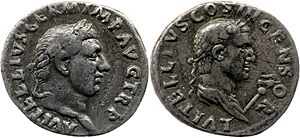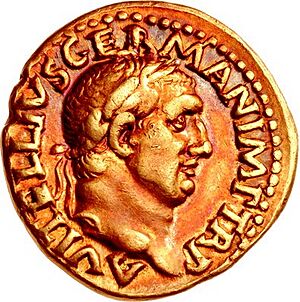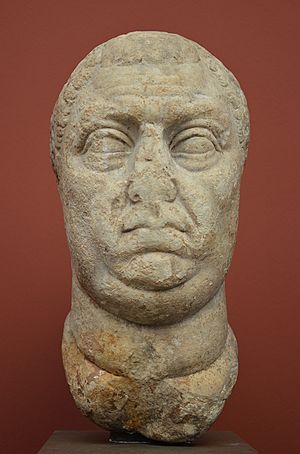Vitellius facts for kids
Quick facts for kids Vitellius |
|||||||||
|---|---|---|---|---|---|---|---|---|---|

A marble statue of Vitellius at the Bardo National Museum in Tunisia.
|
|||||||||
| Roman emperor | |||||||||
| Reign | 19 April – 20 December 69 | ||||||||
| Predecessor | Otho | ||||||||
| Successor | Vespasian | ||||||||
| Born | 24 September 15 Rome, Italy, Roman Empire |
||||||||
| Died | 20 December 69 (aged 54) Rome, Italy, Roman Empire |
||||||||
| Spouse | Petronia Galeria Fundana |
||||||||
| Issue Detail |
|
||||||||
|
|||||||||
| Father | Lucius Vitellius | ||||||||
| Mother | Sextilia | ||||||||
Aulus Vitellius was a Roman emperor who ruled for about eight months in the year 69 AD. This year was very chaotic for the Roman Empire, as four different emperors took the throne one after another. It is known as the Year of the Four Emperors. Vitellius became emperor after Galba and Otho had ruled for short periods.
Vitellius was the first emperor to use the special name Germanicus instead of Caesar when he became ruler. He tried to gain public support by honoring and imitating Nero, a previous emperor who was still very popular.
Vitellius was born in Campania, a region in Italy. His family, the Vitellia gens, was not very well known in ancient Rome. He was a friend of Emperor Tiberius and later Caligula. In 48 AD, he became a Roman consul, which was a high political position. He also served as a governor in the Roman province of Africa.
In 68 AD, Emperor Galba chose Vitellius to lead the army in Germania Inferior. Soon after, the armies in Germania declared him emperor. This started a revolt against Galba. Galba was then killed by Otho, who became emperor. Vitellius then fought Otho and defeated him at the Battle of Bedriacum. After this victory, the Roman Senate recognized Vitellius as emperor.
However, his rule did not last long. Legions in the eastern parts of the empire chose their commander, Vespasian, as emperor instead. This led to another war. Vitellius's forces were badly defeated at the Second Battle of Bedriacum in northern Italy. When he realized he was losing support, Vitellius planned to give up his power to Vespasian. But his supporters would not let him, leading to a fierce battle in Rome itself. Vespasian's soldiers captured Vitellius and executed him on December 20, 69 AD.
Contents
Early Life and Family
Aulus Vitellius was born on September 24, 15 AD, in Nuceria Alfaterna, a town in the Campania region of Italy. His father was Lucius Vitellius, and his mother was Sextilia. He also had a brother, who was also named Lucius Vitellius.
Historians have different ideas about where the Vitellia family came from. Some say they were descendants of old rulers, while others say they had humble beginnings. Since his father only became a senator later in life, Vitellius was the first emperor who was not born into a senatorial family.
When he was young, Vitellius spent time with Emperor Tiberius on the island of Capri. He also became good friends with the young Caligula. They shared a love for chariot racing and dice games.
Becoming Emperor
Early Career and Military Role
Vitellius held important positions in the Roman government. He was a Roman consul in 48 AD. A consul was one of the two highest elected officials in the Roman Republic and Empire. He also served as a governor (called a proconsul) of the Roman province of Africa around 60 or 61 AD. He was said to have done a good job in this role.
At the end of 68 AD, Emperor Galba chose Vitellius to lead the army in Germania Inferior. This was a surprise to many people. In this new role, Vitellius became very popular with his officers and soldiers. He was known for being generous and kind, which sometimes led to a lack of strict order in the army.
The Path to Power
Vitellius became emperor thanks to two army commanders, Caecina and Valens, who led legions along the Rhine River. These commanders refused to promise loyalty to Emperor Galba on January 1, 69 AD.
The very next day, Vitellius was declared emperor in Cologne. He was recognized as emperor by the armies of both Germania Inferior and Germania Superior. Soon after, armies from Gaul, Britannia, and Raetia also joined his side. By the time his armies marched towards Rome, they had to face Otho, who had become emperor after Galba was killed.
Vitellius defeated Otho's forces at the First Battle of Bedriacum. On April 19, the Roman Senate in Rome officially accepted him as emperor. His soldiers entered Italy, and Rome experienced some unrest and celebrations. To reward his loyal soldiers, Vitellius increased the size of the Praetorian Guard and filled it with his own men from the Rhine army.
Vitellius as Emperor
His Time in Charge
Historians have different views on Vitellius's short time as emperor. Some say he seemed to want to rule wisely at first. However, his commanders, Valens and Caecina, encouraged him to focus on lavish parties and celebrations.
Despite his short reign, Vitellius made two important changes to the government:
- He stopped the practice of army officers (centurions) selling time off or special duties to their soldiers. This change was later adopted by other good emperors.
- He also allowed people from the Equites (a class of wealthy Roman citizens who were not senators) to work in the imperial civil service. Before this, these jobs were mostly given to freed slaves.
Vitellius also banned astrologers from Rome and Italy on October 1, 69 AD. Some astrologers responded by secretly publishing their own prediction that Vitellius would not rule for long. In return, Vitellius ordered the execution of any astrologers he found.
He also continued the policies of the previous emperor, Otho, regarding Nero. Vitellius honored Nero's memory and had his songs performed in public. He even tried to act like Nero, who was still very popular among the common people of the Roman Empire.
Challenges to His Rule
In July 69 AD, Vitellius learned that the armies in the eastern provinces had chosen a different emperor: Vespasian. As soon as it was known that the armies in the East, Dalmatia, and Illyricum supported Vespasian, Vitellius sent his legions under Caecina to stop them from entering Italy. However, Caecina was unhappy with Vitellius's leadership and tried to switch sides to Vespasian.
This caused the morale of Vitellius's soldiers to drop, and they were badly defeated at the Second Battle of Bedriacum. Fabius Valens, another of Vitellius's commanders, was sent to gather more armies in Gaul, but he was captured and executed by Vespasian's loyal forces. Many of Vitellius's supporters then left him, and he prepared to give up his title as emperor.
Giving Up Power and Death
Vitellius waited for Vespasian's army at a place called Mevania. He had even agreed to the terms of his abdication (giving up power) with Marcus Antonius Primus, one of Vespasian's main supporters. However, as Vitellius was on his way to place the symbols of his power in the Temple of Concord, the Praetorian Guard stopped him. They refused to let him carry out the agreement and forced him back to the palace.
When Vespasian's troops entered Rome, Vitellius's remaining supporters, mostly civilians, fought back fiercely. They threw stones, spears, and tiles from buildings, causing many casualties for Vespasian's soldiers in the street fighting. Large parts of the city were destroyed, including the important Temple of Jupiter Optimus Maximus.
Vitellius was eventually found hiding. He was dragged to the Gemonian stairs, a place where criminals were executed, and killed by Vespasian's supporters. His last words were, "Yet I was once your emperor." His brother and son were also killed.
Family Life
Vitellius was married twice. His first wife was Petronia, and they had a son named Aulus Vitellius Petronianus. This son was set to inherit a large fortune from his mother and grandfather.
Later, around 50 AD, Vitellius married Galeria Fundana. They had two children: a son named Aulus Vitellius Germanicus (or Novis, the Younger) and a daughter named Vitellia. Vitellia later married a man named Decimus Valerius Asiaticus.
Portrayals
On Coins
Since Vitellius was not officially recognized as emperor by the Senate until April 19, 69 AD, he had to use mints (places where coins are made) outside of Rome at first. He used mints in Spain and Gaul (modern-day France). These mints closed in the summer, and then the mint in Rome took over.
Every coin of Vitellius includes the title "Germanicus." This title referred to the legions from the Rhine River who supported him in becoming emperor. On the coins, this title was often shortened to "Germ." This shows how important this title was to Vitellius. Coins minted before April 19 did not have the title "Augustus," but coins minted after July 18, when he became "Pontifex Maximus" (chief priest), included that title.
The last coins Vitellius made were gold and silver coins showing the goddess Victory building a trophy. This likely showed his hope for victory against Vespasian's approaching armies.
In Art
Statues (busts) from Vitellius's time, especially one in the Capitoline Museums, show him with a broad face and multiple chins. This image has influenced how painters have shown him since the Renaissance.
Many artists in the 19th century painted scenes of Vitellius's violent death. For example, a painting by Georges Rochegrosse (1883) shows him being dragged by a crowd down the steep Gemonian stairs. He is shown tied up and surrounded by a shouting mob. Other paintings show the moment he was executed.
Vitellius also appears in the famous painting The Romans in their Decadence (1847) by Thomas Couture. In this painting, Vitellius is shown in shadow, suggesting a bleak future.
In Stories
Vitellius's father, Lucius Vitellius, appears in some stories set in ancient Rome. For example, he is a character in Gustave Flaubert's novella Hérodias (1877) and in the opera Hérodiade.
Aulus Vitellius himself plays a small part in Henryk Sienkiewicz's novel Quo Vadis, which is set during Emperor Nero's reign. He also appears in more recent novels that focus on the Year of the Four Emperors. For example, he is in Kate Quinn's Daughters of Rome (2011) and Steven Saylor's Empire: The Novel of Imperial Rome (2010). His fall is shown in M C Scott's Rome, The Art of War (2013), and he also appears in James Mace's two-part series, The Year of the Four Emperors.
Images for kids
See also
 In Spanish: Vitelio para niños
In Spanish: Vitelio para niños







